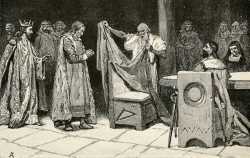|
The story of the Holy Grail is one of the most prominent stories which features into Arthurian legend. Like many of the tales associated with King Arthur, it has a historical basis, but over generations of retelling the story, it has taken on different twists.
Historically, the grail is considered to be some sort of container - generally a goblet - although this varies. There may be a basis of a cauldron with special powers in Celtic myth. The grail also portrayed as the cup from which Christ drank at the Last Supper and/or also may have been the chalice used to collect his blood after his crucifixion. Joseph of Arimathea - who has been theorized to be Christ's great uncle - is, depending on the account, thought to be the person who brought the grail to England. It has specifically been tied to Glastonbury, which is generally considered the site of Avalon in Arthurian legend. It also considered to be the site of the first Christian church in England, built by Joseph of Arimathea. |
 image from messiah.edu |
|
Chrétien de Troyes introduced the Holy Grail to Arthurian legend via his unfinished work, Le Conte du Graal (c. 1185), also known as Perceval le Gallois. The knight Perceval (later called Sir Galahad) encounters the Fisher King, who is stuck in limbo between life and death. Perceval is tasked with the quest of retrieving the Holy Grail, which will relieve the Fisher King of his suffering.
French poet Robert de Boron also took up the tale with three books, of which only Joseph d' Arimathea (c. 1200), has survived in tact. It has been retold as one of the Vulgate cycles in Estoire de Saint Graal (c. 1240). Fragments of the second, Merlin, exist and the third, Perceval, is lost. Didot Perceval (c. 1205) is considered a version of the latter, written anonymously in prose. In Joseph d' Arimathea, Boron extends the story of Perceval by introducing the idea that he is the pure knight who can sit at Siege Perilous, a special seat at the Round Table.  image from pantheon.org In the context of the Otter and Arthur stories, the grail is shaping up to be the centerpiece of a possible third book, Otter and Arthur and the Holy Grail. While there is only a rough sketch at this time, the basic premise of the story may be that it is Sir Gawain who seeks the Holy Grail, an idea first put forth in Heinrich von dem Türlin's poem Diu Crône (c. 1220), which in English means "The Crown." |
Resources:
|











No comments:
Post a Comment